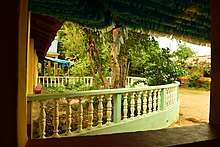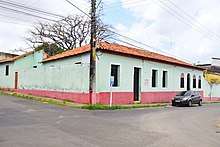Mãe Andresa
Andresa Maria de Sousa Ramos, known as Mother Andresa (Caxias, Maranhão, 1854 - 1954), was a great priestess (vodunsi) of the Tambor de Mina, cult of voduns in Maranhão.[1]
Considered the last direct lineage princess Fon, her African names given by the voduns were Ronçoiama and Rotopameraçulem (name given after the barco, or initiation ceremony). Mother (or Mãe, in Portuguese) Andresa coordinated the Casas das Minas, the most important temple of Tambor de Mina in Maranhão, between 1914 and 1954. Died at 100 years of age.[1]
Biography

A descendant of slaves, Mother Andresa was born in Caxias. She came still young to São Luís, seeking health treatment. She went into a trance with the vodum Tói Poliboji (a deity of the Tambor de Mina) the age of seven or eight. She completed her initiation on a barco of 12 vodunsis hunjaís (the "complete daughters", priestesses who receive in addition to a vodum, a tobossi), probably before 1900, when the temple was headed by Mother Luisa, the second head of the Casa das Minas.[2]
In 1914, he succeeded Mãe Hosana (who had succeeded Mãe Luisa), when he was about 60 years old, and devoted himself entirely to the house. She never married, and she would have worked selling food in her youth to support herself.[2]
She was friends with several ancient priestess of São Luís, having had respectful relations with other ancient terreiros. Known for its generosity, she was much sought after by people from various cities of Maranhão, even in case of illness, as there was a garden with medicinal plants in the temple. Several friends sent groceries to the Casa das Minas, and Mother Andressa ordered to distribute the leftover food so that they did not spoil.[2]
She had about a hundred godchildren, and she loves children very much. She raised Maneco, chief player of the House; Dona Amância, head of the House between 1972 and 1976; and Dona Deni, chief between 1997 and 2015. She did not prepare other barcos (initiation ceremonies) for vodunsis hunjaís.[2]

While heading the temple, she had to sell jewelry to pay taxes during World War II. In the Estado Novo, there were persecutions of the terreiros in São Luís and attempts to transfer them to the outskirts of the city. However, Governor Paulo Ramos authorized the Casa das Minas and the Casa de Nagô to remain because they are very old.[2]
For the last 20 years of her life, she was visited by several Brazilian and foreign journalists and researchers, who interviewed her and she provided information about the worship and the history of the temple.[2]
At the end of her life she could no longer walk, although she was still lucid. In 1953, President Café Filho was in São Luís and visited Casa das Minas.[2]
She died on April 20, 1954, on a Holy Thursday, after directing the House for four decades, and there was a year's mourning in the temple.[2]
References
- "Casa das Minas" (in Portuguese). Archived from the original on 21 June 2014. Retrieved 18 December 2014.
Andresa Maria de Souza Ramos, que carregava o vodum Tói Poliboji e chefiou a Casa entre 1914 e 1954, tornou-se uma das mais célebres iyalorixás, pelo seu carisma, tendo recebido dos voduns o nome de Rotópameráçulême. Na sua época, o terreiro era também chamado de “Casa de Mãe Andresa”. Era celibatária, uma característica, não regra, entre as vodúnsis que ali residem.
- da Silva, Vagner Gonçalves (2002). "Caminhos da alma: memória afro-brasileira".